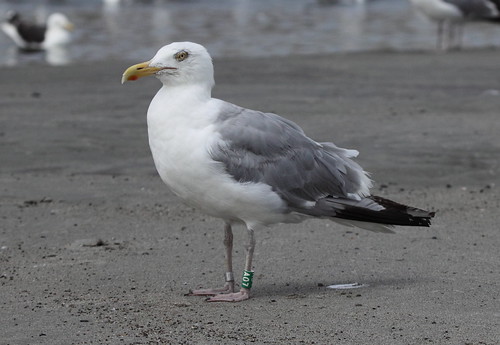Birding to many is about getting outside and seeing what you can find. It's about the challenge of an identification, the pursuit of a new species (for your life, state, year, month, or day list), and about having fun. What many people fail to realize or investigate are bigger picture questions dealing with migration patterns, seasonal distribution, distribution on breeding grounds, distribution in migration, overwintering challenges, habitat use, etc.
Lately these sorts of topics have been dominating and directing my birding (along with the desire to find out if this is ACTUALLY an early spring or if it just seems that way... more on this later though).
While there are some species which we know a lot about, it is safe to say that for almost every single species, even the most common (such as your local species of Chickadee) there are many more things that are unknown about its life, behavior, and distribution. There are many examples of ways that people can investigate these species more without much effort and fill in the gaps of our knowledge. One of my favorite examples is counting migrating goldfinches. I'm sure NH birders are laughing and already know what I'm talking about here, but for the rest of you here's a bit more information. During migration, two of NH's best birders (Steve and Jane M.) hit the coast and park at a spot they like to call "cutsie dootsie" and count migrating goldfinches overhead. Since American Goldfinch is common year-round in NH most people aren't invested in detailed observations of this species. Something as simple as counting the number of goldfinches migrating past forms a unique data pool for a species in which most people are familiar with.
While we information like this is helpful for all species, there are a few groups of species which deserve specific attention as there is extremely little known about them on their breeding grounds. These include: grassland(including salt marsh), bog/boreal, and early-successional species. Right now there is great need for information on species within these habitats as so little is known and without good information conservation efforts will not be informed.
(Vesper Sparow - one of many grassland species which is under threat due to destruction of habitat)
I'm sure the citizen-scientist part of birding isn't for everyone. I'm also sure that many people think that understanding distribution isn't a necessary part of birding. Perhaps it's not. However, I would argue that understanding distribution, investigating questions related to distribution, understanding vagrancy patterns, etc. all make one a better birder.
So the next time you see a bird - ask yourself, how much do you really know about it? Do you know much more than field marks? Do you know if it nests on the ground, in trees, or in sphagnum bog mats? What does it eat? Does it migrate, and if so when? Is it habitat specific? Does it prefer certain plants? If its a rare bird, is this a typical time for it to show up as a vagrant? Is its likelihood for vagrancy dependent on weather conditions; what sorts of weather conditions?
If I described a bird as glossy black with red and yellow shoulder badges with a slender conical bill you would probably immediately know I was talking about a Red-winged Blackbird. If you saw the following photo you'd probably know it was a Red-winged Blackbird.
But did you know that Red-winged Blackbirds build their nest low within marsh vegetation or in low shrubs? Did you know that the females choose the nest site yet males have some input? Did you know that sedges, phragmites, cattail, alder, willow and other plants are suitable vegetation for nests? Did you know that the oldest recorded lifespan is 15 years and 9 months? Did you know that Red-winged Blackbirds are highly polygynous?
In some states Red-winged Blackbirds overwinter, in others they don't. Sometimes they form HUGE concentrations (hundreds of thousands) to roost.
Here's a video of a mixed blackbird flock headed to roost in NH. On this particular day we estimated 200,000 blackbirds going to roost. Others estimated 500,000 on a later date...
So the next time you see a bird... think... do you know more than just field marks? Do you know anything about its life? How does your sighting fit into the picture of distribution on a local, regional, and national level?










































